Could Not Read or Parse the Jnlp File Ice Tea
| Notation | The authors assume no responsibility or liability for whatever errors or omissions in the content of this documentation. The data contained in this documentation is provided on an "as is" ground with no guarantees of completeness, accuracy, usefulness, timeliness or of the results obtained from the use of this information. |
This Guide refers to the OpenWebStart version 1.six.0-SNAPSHOT and was build at xvi.02.2022.
Introduction
Java Web Commencement (JWS) was deprecated in Java 9, and starting with Coffee xi, Oracle removed JWS from their JDK distributions. This means that clients that have the latest version of Java installed can no longer apply JWS-based applications. And since public support of Java 8 has ended in Q2/2019, companies no longer get whatsoever updates and security fixes for Java Web Beginning.
This is why some enthusiasts at Karakun decided to create OpenWebStart, an open source reimplementation of the Java Web First technology. This guide describes how you lot tin can utilise OpenWebStart as a replacement for JWS and continue using your JNLP-based applications with little or no change at all.
We appreciate your feedback. If you lot experience that at that place'south a lack of documentation in a certain area or if you discover inaccuracies in the documentation, please don't hesitate to contact us at openwebstart@karakun.com or the support forum.
What is OpenWebStart?
OpenWebStart is an open up source reimplementation of the Java Web Start technology, released under the GPL with Classpath Exception. It provides the most normally used features of Coffee Web Start and the JNLP standard, and then that your customers tin continue using applications based on Coffee Web Start and JNLP without any change. OpenWebStart is based on Iced-Tea-Spider web and follows the JNLP-specification defined in JSR-56.
The focus of OpenWebStart is the execution of JNLP-based applications. Additionally, the tool contains various modules that simplify your Spider web Kickoff workflows and let you lot configure OpenWebStart to suit your needs:
- App Manager
-
Manages the versions of whatever JNLP-based application that is executed by OpenWebStart.
- JVM Manager
-
Manages Java versions and Coffee updates on the client.
- Control Panel
-
Provides a graphical user interface to configure OpenWebStart.
- Updater
-
Downloads and installs new versions of OpenWebStart.
Installation
OpenWebStart can be installed on Windows, MacOS and Linux operating systems and there are two different means to install OpenWebStart:
-
Using the interactive installation with auto-update functionality
-
Using the unattended installation for automated roll-outs
If you use Spider web Get-go for several small customers or on your own, we recommend using the interactive installer. Our native installer will set upward everything on your Windows, Mac, or Linux system so that OpenWebStart is immediately fix to apply. OpenWebStart checks for updates automatically, and the Updater component keeps the tool current without the demand for any user interaction.
If you or your customers are companies with IT departments of their own, we recommend an unattended installation to roll out OpenWebStart on multiple customer machines with similar configuration. Instead of walking through the graphical installer of OWS on every automobile your IT section tin pre-define the responses for the installation options in a response varfile.
Interactive Installation
Windows
-
Open up the ZIP-file.
-
Run the installer.
-
Cull a language and click OK to open up the OpenWebStart Setup wizard.
-
Click Adjacent to start the OpenWebStart installation.
-
Browse to the directory where to install OpenWebStart, and click Next.
Windows default:C:\Program Files\OpenWebStart -
Enable the checkbox to associate the .JNLP suffix with OpenWebStart, and click Next.
-
Please wait for OpenWebStart to exist installed on your computer.
-
Click Finish on the completion screen to close the wizard.
macOS
-
Open the OpenWebStart disk image (DMG file) to mountain it.
-
Run the
Open up Web Outset Installer.app. -
Choose a language and click OK to open the OpenWebStart Setup wizard.
-
Click Next to start the OpenWebStart installation.
-
Browse to the directory where to install OpenWebStart, and click Side by side.
Default:/Applications/Open Web Start -
Enable the checkbox to associate the .JNLP suffix with OpenWebStart, and click Next.
-
Delight wait for OpenWebStart to be installed on your computer.
-
Click Stop on the completion screen to shut the wizard.
Linux
-
Go to the directory where the installer (DEB file) is stored and run the file from the last
sudo dpkg -i OpenWebStart_linux_1_1_8.deb -
Enter your root password.
-
Choose a linguistic communication and click OK to open up the OpenWebStart Setup sorcerer.
-
Click Next to start the OpenWebStart installation.
-
Scan to the directory where to install OpenWebStart, and click Next.
Default:/opt/openwebstart -
Enable the checkbox to associate the .JNLP suffix with OpenWebStart, and click Next.
-
Please wait for OpenWebStart to be installed on your computer.
-
Click Finish on the completion screen to shut the wizard.
If you need help to install OpenWebStart, likewise take a wait at the public installation and configuration discussions at the Support Forum.
Installation Artifacts
The artifacts of an installed release are the follows:
- OpenWebStart main executable
-
Application to launch a JNLP file.
-
javaws.exe (Windows),
-
OpenWebStart javaws.app (macOS)
-
- OpenWebStart settings executable
-
Application to configure your OpenWebStart installation.
-
itw-settings.exe (Windows),
-
OpenWebStart Settings.app (macOS)
-
- Uninstaller executable
-
Application to uninstall OpenWebStart from your system.
-
uninstall.exe (Windows)
-
OpenWebStart Uninstaller.app (macOS)
-
- jre directory (Windows)
-
The arranged JRE that starts OpenWebStart
- javaws.vmoptions
-
JVM arguments used by the bundled JRE when starting OpenWebStart main executable (javaws)
- itw-settings.vmoptions
-
JVM arguments used by the bundled JRE when starting OpenWebStart settings executable (itw-settings)
- .install4J directory
-
Contains install4j installer files including response.varfile used for the unattended installation.
- openwebstart.jar
-
OpenWebStart application jar
- *.png
-
Some icons used by OpenWebStart
- readme.txt
-
Describes OpenWebStart release contents and useful links
Unattended Installation
An unattended installation allows for a silent installation and does not prompt you for any input. Use a silent installation when at that place are like installations to be performed on more than i reckoner. In this scenario, the machine-update functionality is inactive; your It department is free to plan and handle rollouts of new versions based on your internal workflows.
When installing OpenWebStart, several properties tin be predefined in a so-chosen response.varfile file.
Some supported backdrop are lockable. If a belongings is lockable, you can define an additional holding of blazon PROPERTY_NAME.locked=true to prevent users from editing the property in the user interface. For example, to ascertain a value for the ows.jvm.managing director.server.default property that cannot be inverse in the user interface, specify the post-obit 2 properties:
ows.jvm.managing director.server.default=https://my.custom.server ows.jvm.manager.server.default.locked=true
Have a expect at the Configuration Properties Overview to get an overview of all properties that can exist specified in the response.varfile.
To create a response.varfile file, run the installation of OpenWebStart at to the lowest degree once manually. By doing so a response.varfile file is created in OpenWebStart installation folder in your system. In the installation folder, you find a .install4j folder that contains the basic response.varfile file. Shop this file in a location where you tin can call back it later. The content of such a file looks like this:
sys.adminRights$Boolean=false sys.fileAssociation.extensions$StringArray="jnlp","jnlpx" sys.fileAssociation.launchers$StringArray="313","313" sys.installationDir=/Applications/OpenWebStart sys.languageId=de
You lot tin can easily edit this file and add together additional properties based on the table in this article. Practise not remove the initial content of the file, modify the values as necessary, and add new properties ever to the end of the file. After editing, a response.varfile the file might look like this:
sys.adminRights$Boolean=fake sys.fileAssociation.extensions$StringArray="jnlp","jnlpx" sys.fileAssociation.launchers$StringArray="313","313" sys.installationDir=/Applications/OpenWebStart sys.languageId=de ows.jvm.manager.server.default=https://my.custom.server ows.jvm.manager.server.default.locked=true
Y'all tin command whether you want to run the installer with admin rights and whether you desire to install for the Current User or for All Users past specifying the following properties:
Install For All Users:
Install For Current User:
Run the Installer without admin rights:
sys.adminRights$Boolean=faux
Run the installer with admin rights:
sys.adminRights$Boolean=true
Yous tin can now use your enhanced file to install OpenWebStart on multiple machines. Simply copy the enhanced response.varfile next to the installer and execute the following control:
<OpenWebStart_windows_1.ten.x.exe> -q -varfile response.varfile
hdiutil adhere OpenWebStart_macos_1_x_x.dmg /Volumes/OpenWebStart/OpenwebStart\ Installer.app/Contents/MacOS/JavaApplicationStub -q -varfile response.varfile hdiutil detach /Volumes/OpenWebStart
Installation Directory for Unattended Installer
For the unattended installation, you may specify the installation directory in response.varfile as follows:
If you specify accented path, e.g. sys.installationDir=c:\test, then OWS will be installed there.
If you specify relative path, e.g. sys.installationDir=test, then OWS will be installed in the specified directory relative to the directory where the unattended installer command is executed.
If you remove the property sys.installationDir, then for Current User (userMode$Integer=0), OWS will be installed in <User Home>\AppData\Local\Programs directory and for All Users (userMode$Integer=ane) OWS volition exist installed in C:\Program Files\OpenWebStart directory.
If y'all would like to install OWS relative to User's Home directory, you lot can override sys.installationDir in response.varfile by specifying -dir command line argument as follows:
OpenWebStart_windows-x64_x_x_x.exe -q -varfile response.varfile -dir %USERPROFILE%\<the dir where you want to install ows>
JNLP File Association
To ensure that your computer handles links, desktop shortcuts, or start menu entries to JNLP applications correctly, you should associate the JNLP file type (*.jnlp) on your computer with OpenWebStart. In case yous used an Oracle JVM in the past, your JNLP file association might nevertheless exist ready to Oracle javaws.
Notation that during the installation procedure, OpenWebStart volition not change file associations of whatsoever existing Oracle javaws executable, so you can use both.
To associate .JNLP applications in Windows Explorer
-
Right-click the JNLP app and select Open With > Choose Some other App
-
Click More Apps and scroll downwards
-
Click Look for Another App on this PC
-
Scan to OpenWebStart at
C:\Program Files\OpenWebStart\javaws -
Click Open to associate this JNLP file with OpenWebStart
To associate .JNLP applications in macOS Finder:
-
Right-click the JNLP app and select Open With > Other…
-
Browse to OpenWebStart at
/Applications/Open up Spider web Offset/javaws -
Click Open to associate this JNLP file with OpenWebStart
How to Uninstall
In instance you need to uninstall OpenWebStart follow the steps below:
- For Windows and macOS
-
-
Go to your OpenWebStart directory
-
Run the Uninstaller
-
Click Adjacent in the OpenWebstart Uninstaller Magician
-
Expect for the Uninstaller to complete
-
Click Finish on the completion screen to close the wizard.
-
- For Linux
-
Use your package director and remove the package OpenWebStart
Running OWS from portable USB stick
Information technology is possible to run OWS from a portable USB stick without really installing OWS on your motorcar. Although this is a quick way of running OWS, the downside of not using the installer is that you lot exercise not get the support of the underlying operating organization in terms of file associations, registry entries and desktop integration. So if you tin can (and want to) do without the file associations, desktop icon and startup carte you can create a portable version past yourself.
All files required for execution are located in the installation directory (see Installation Artifacts. It is therefore sufficient to copy this directory onto a USB stick and and then to run the primary executable (Windows: javaws.exe) and settings executable (Windows: itw-settins.exe) by mounting the USB stick on the target computer.
If yous want the settings and the cache to also remain on the USB stick, the path to these 2 directories tin can be set with the following surround variables:
XDG_CACHE_HOME (default value is %USER_HOME%\.cache) XDG_CONFIG_HOME (default: %USER_HOME%\.config) To run OWS from a USB stick it is recommended to create a small-scale batch script that sets the ii variables and then executes the executables:
javaws.exe [url-to-jnlp | path-to-jnlp] [options] It should too exist mentioned that with a new release of OWS the two things that usually change are:
\openwebstart.jar (the application must be updated) \jre\ (the bundled JRE which is used to run OpenWebStart) So you might want to update these files on the USB stick to proceed your OWS installation up-to-date.
Local vs. System-Wide Installation
You tin install OWS for the electric current user (without admin privileges) or for all users (with admin privileges) of the computer.
| Note | Having more than one installation of OWS on your motorcar, specially when one installation is for current user (i.e. without admin privileges) and the other 1 is for all users, may result in overwriting registry entries. This can lead to a situation where you do not know which bodily OWS is invoked to run the _jnlp file started for example past double-clicking. |
In one case OWS is installed on your machine it can exist configured locally using the local deployment.properties file or it can have its configuration from a centralized, enterprise wide deployment.properties file that is specified in the deployment.config file. This is described in detail in the section on Configuration.
Updates
OpenWebStart can exist configured to automatically check for new releases and perform automated updates.
To do then go to the "Updates" Console in the OWS Settings.
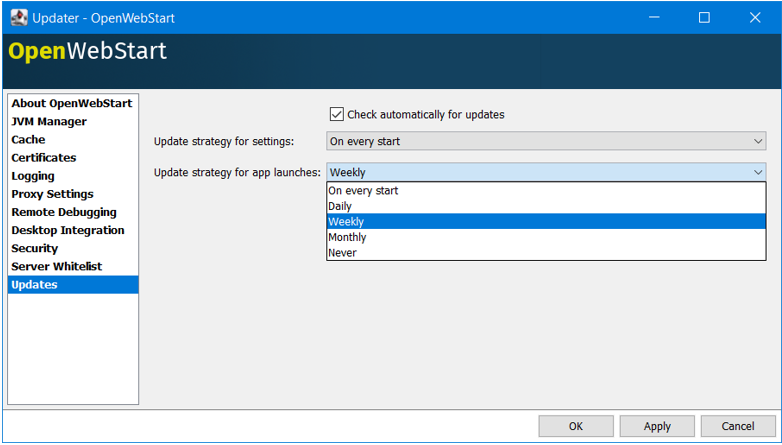
Figure ane. OWS Update options
It is possible to define an update strategy on every start, daily, weekly, monthly, or never.
Configuration
The standard way to configure OpenWebStart is to employ the OpenWebStart Settings application. The executable is located in the installation directory and is named itw-settings.
Diverse life-bike aspects of your JNLP applications tin can be configured, such every bit download and update strategy or caching behavior. Yous can configure the JVM vendor and version that should exist used to launch your JNLP application as well every bit proxy settings, security settings, certificates and server whitelists.
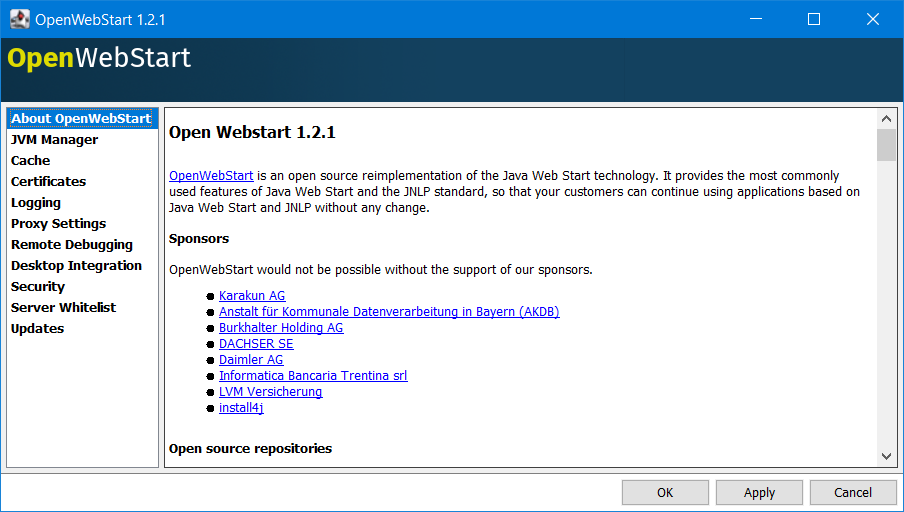
Figure 2. Configuring OWS Settings
Configuration Lookup Lifecycle
When loading the configuration during the outset of OpenWebStart the post-obit steps are executed:
-
Load the default values which are hardcoded in the source lawmaking.
-
Search for a System Configuration.
-
Load the Organisation Configuration (if one has been specified).
-
Load the User Configuration.
Whenever a configuration is loaded the values which are already defined in a previous lifecycle step are updated. There is however the possibility to lock a property on a system-level lifecycle stride. If a property is locked then subsequent configurations may not modify the value. This allows enforcing certain values on a arrangement level. Any changes a user makes in his local user configuration file will not have any effect on a locked property.
User Configuration
The local user configuration properties are stored in a file chosen deployment.properties.
-
For Windows the file is located at
${USER_HOME}\.config\icedtea-web\deployment.properties. -
For MacOS and Linux the file is located at
${USER_HOME}/.config/icedtea-web/deployment.properties.
This file tin can be edited with a regular text editor. For some specific configurations manually editing this file might exist necessary, but for nearly cases the OWS Settings awarding is sufficient.
System Configuration
In an enterprise environment, for uniformity of behavior, information technology is preferred that all users apply the aforementioned configuration for OWS.
It is possible to configure OWS with a system-wide configuration. This allows setting up a mutual configuration for multiple users at a centralized location on a single reckoner. This helps in managing a corporate infrastructure where many computers need to be configured identically.
Creating a Organisation Configuration
The simplest manner to create a organization configuration is to commencement the itw-settings. After adjusting and saving as you prefer, the configuration the modified properties are written to the local deployment.properties file as described above. This customized user configuration can exist used equally a starting point for the system configuration. Simply copy the file and remove the properties which should not be pre-defined at system-level.
OpenWebStart does not save an entry for a property in the deployment.properties file if information technology is set to the default value. Therefore, the generated user configuration may non contain all the values you wish to enforce on the system level. Where advisable y'all have to add boosted backdrop manually.
| Note | Please refer to Configuration Properties Overview for a comprehensive list of deployment properties. |
It is possible to brand OWS utilize deployment.properties from a customized location.
The location of such an optional system-level deployment.properties file is defined in a deployment.config file. For OWS to find the deployment.config file it must be located in specific location:
-
For Windows in
<Windows Directory>\Sun\Java\Deployment\deployment.config -
For MacOS and Linux in
/etc/.java/deployment/deployment.config
The deployment.config file is a regular backdrop file. The following properties can be set to configure the location of the organization configuration file:
- deployment.system.config
-
The URL to the system configuration. The name of the arrangement configuration tin can be freely chosen. Special characters need escaping. See the following examples:
-
deployment.organization.config=file\:/C\:/Windows/Lord's day/Java/global.backdrop -
deployment.system.config=file\:/etc/.coffee/deployment/base of operations.properties -
deployment.organisation.config=https\://192.168.1.1./javaws/system.properties
-
- deployment.system.config.mandatory
-
If gear up to
truethen OpenWebStart will fail if it is unable to load the organization settings This property is optional. The default value isfalse.
The final file should expect something like this:
deployment.organization.config=https\://192.168.1.1./javaws/arrangement.properties deployment.system.config.mandatory=true OWS specific System Configuration
OpenWebStart tries to mimic the behavior of Oracle's web outset (JWS) but it is not exactly the same. On some systems OpenWebStart is used besides Oracle's spider web commencement. In such a constellation it is possible that the organisation configuration needs to be different for Oracle JWS and OWS. Therefore, OWS allows the user to specify OWS specific deployment.config called itw-deployment.config. The content of the file is the aforementioned as described above. OpenWebStart will pickup itw-deployment.config while Oracle will use the original deployment.config file. In the absence of itw-deployment.config OWS uses the original deployment.config.
Locking a Property
Ane of the use cases is to enforce some configurations to all users in your corporate surroundings. This tin can be achieved by locking configuration on a system level. To lock a holding you need to define a second entry with a .locked postfix.
Here is an example:
ows.jvm.manager.server.default=https\://192.168.1.i/jvms.json ows.jvm.manager.server.default.locked=true | Tip | the value of ows.jvm.managing director.server.default.locked is ignored. The presence of the key is sufficient for locking the property. |
Organization-wide trust store for trusted certificates
OWS has a property deployment.system.security.trusted.certs to signal to a trust store where OWS will look for trusted certificates.
Suppose your trusted certificates are stored in a trust store called trusted.certs. You tin can copy this file to a central location.
The property deployment.system.security.trusted.certs can exist specified in a system level deployment properties file, e.thou. itw.properties :
deployment.system.security.trusted.certs=<Central Directory>\\trusted.certs deployment.organisation.security.trusted.certs.locked
Specify the organisation level deployment backdrop file in the System-broad config file C:\Windows\Sun\Java\Deployment\itw-deployment.config:
deployment.system.config=file:///<Central Directory>/itw.backdrop deployment.organization.config.mandatory=true
To verify certificates, OWS volition at present use the central trust store that is specified in the system level deployment properties file.
Customize Application Cache and User Config Location
Centralized location for the configuration and enshroud can be specified using XDG_CONFIG_HOME and XDG_CACHE_HOME environment variables.
The centralized configuration comprises:
-
deployment.properties : all users must use the same deployment.backdrop for OWS
-
user decisions (.appletTrustSettings)
-
logs - logs for the app started by each user
-
security (certificate stores)
-
icons - for the app started by user
The centralized cache comprises
-
jvm_cache : directory where common fix of downloaded JVMs are stored (this tin can exist separately configured using the
ows.jvm.manager.cache.dirproperty) -
cache and recently_used file : directory for caching the jnlp and resource of the applications started by users
-
temp dir : Directory created past OWS for temp files.
JVM Management
OWS provides facility to choose set of JVMs that can be used to run the applications specified in JNLP files
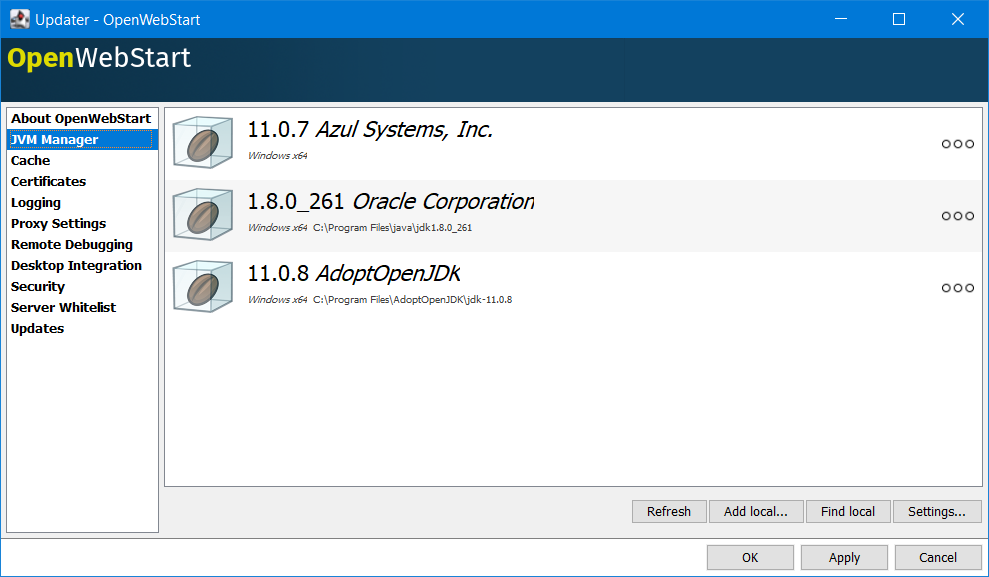
Effigy three. JVM Management
One can choose or automatically add locally available JVMs or one tin can specify the server from where JVMs can be downloaded.
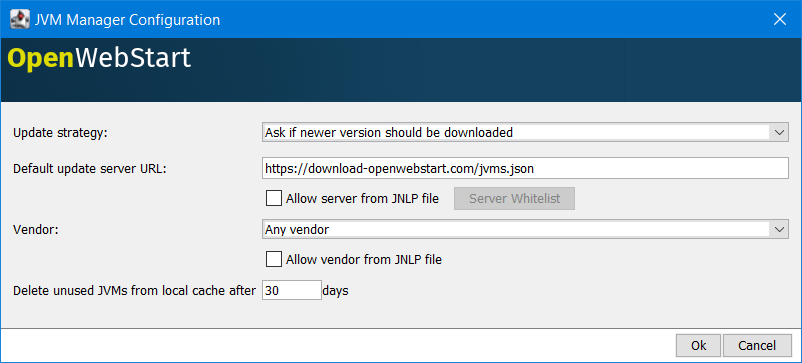
Figure four. Configuring JVM Management
Customize JVM Enshroud Location
The jvm_cache location tin be configured using the property ows.jvm.managing director.cache.dir in the deployment.properties file:
ows.jvm.managing director.enshroud.dir=c:\\temp\\JVMCacheDir | Annotation | ows.jvm.manager.cache.dir specification in deployment.backdrop takes precedence over XDG_CACHE_HOME. |
JVM Download Server
OpenWebStart can fetch JVMs and JVM updates from a download server that is specified in the JVM Manager Configuration of the OWS Settings application. The default points to https://download-openwebstart.com/jvms.json.
Set up up a Custom Download Server
If you want to set up your own JVM download server you lot must provide a json file which lists all available JVMs.
This json file must comprise the following data:
{ "cacheTimeInMillis":<miliseconds>, "runtimes":[ { "version":<JVM version>, "vendor":<vendor name>, "os":<OS identifier>, "href":<absolute url to the archive containing the JVM> }, ... more runtime definitions } - cacheTimeInMillis
-
The time which needs to elapse before a client is allowed to contact the server again. Usually the server is accessed once per application startup.
- os
-
Possible values are: MAC64, MAC32, LINUX64, LINUX32, WIN64, WIN32
Allowing JVM Server in JNLP and defining a JVM Server Whitelist
You tin can allow the specification of JVM server in the JNLP file by defining the property: ows.jvm.manager.server.allowFromJnlp=true. In this case the JVM will be downloaded from the URL specified in the JNLP file:
<java version="ane.eight*" href="http://myjvms.myserver.com/jvms.json"/> When allowing JVM server download from the JNLP file, as a security measure it is advisable to define a whitelist for JVM server URLs that will be specified in JNLP files. JVMs volition be immune to be downloaded from only those server URLs that friction match a whitelist entry.
The JVM server whitelist can exist defined in the deployment properties file:
ows.jvm.managing director.server.allowFromJnlp.whitelist=myjvms.myserver.com, *.jvms.com Information technology is possible to specify wildcards in the URLs specified in the whitelist. Delight see the section on "Server Whitelist" for details.
Searching for local JVM
OpenWebStart tin can search for already installed JVMs on your local file system. This is done past checking in a few default locations. The list of default locations is by no means exhaustive. Thus it is possible that OpenWebStart will not discover all JVMs on the local file system.
There are a few settings which tin can be used to configure the search for local JVMs. Meet Configuration Properties Overview for a detailed description of the properties.
ows.jvm.manager.searchLocalAtStartup=true ows.jvm.manager.excludeDefaultSearchLocation=truthful ows.jvm.manager.customSearchLocation=c\:/path/to/jvm,c:\\path\\to\\other\\jvm Whitelist for JVM Arguments
OWS starts the JNLP awarding with the JVM that best matches the JVM in the JNLP file. While starting the JVM, OWS passes the JVM arguments specified in the JNLP file:
<coffee version="1.eight+" java-vm-args=" -Xmx512m -Xms128m -20:SurvivorRatio=half-dozen -XX:NewSize=96m -Twenty:MinHeapFreeRatio=20 -20:MaxHeapFreeRatio=xxx"/> The version number specified can either end with a number, and asterisk or a plus sign.
i.8 would hateful the version must be one.eight. one.7* means anything at or college than ane.vii but less than i.8 (like 1.7.1). i.7+ means anything 1.7 or higher (including 1.8, nine or 11).
OWS maintains a hardcoded listing of secure JVM arguments every bit specified at:
-
https://docs.oracle.com/javase/8/docs/technotes/guides/javaws/developersguide/syntax.html#secure-property
-
https://docs.oracle.com/javase/ix/tools/java.htm#JSWOR624
-
https://news.kynosarges.org/2019/03/24/swing-high-dpi-properties/
OWS allows just those JVM args that are in the higher up lists. However, sometimes with new versions of JREs new JVM arguments are introduced. Also, some desired arguments are not included in the above lists. In such cases it is possible for the user to specify additional JVM arguments in the deployment.properties for OWS to allow them to be passed to the JVM:
deployment.jvm.arguments.whitelist=-Dnew_jvm_arg1, -Dnew_jvm_arg2 Subsequently the JNLP file can include the above JVM args:
<coffee version="10" java-vm-args="-Dnew_jvm_arg1=value1 -Dnew_jvm_arg2=value2"/> Note: The whitelist should just incorporate the name of the JVM argument and not the value equally can exist seen in the case in a higher place.
Specify a specific vendor in the JNLP file
As illustrated higher up in figure 4, you can specify the vendor that should be taken into consideration for selecting the JVM that launches your JNLP awarding.
In addition to that, it is possible to specify a JVM vendor in the JNLP file itself:
<java version="1.8*" vendor="AdoptOpenJDK" ... /> You tin can utilise one of the following vendor names/allonym every bit value for the vendor aspect:
"*" "AdoptOpenJDK", "Prefer" "Amazon.com Inc.", "Amazon Inc.", "Amazon" "Azul Systems, Inc.", "Azul" "BellSoft" "Eclipse Adoptium", "Adoptium" "Oracle Corporation", "Oracle"
The asterix is the same as if yous skip the vendor attribute. It means "any vendor" volition exist fine. This is the default.
If there is no specific vendor specified in the OWS Settings UI (i.e. "Any Vendor" selected), the vendor attribute specified in the JNLP file will be considered by default. If no vendor hint is set in OWS Settings and the JNLP does not contain any vendor information, the starting time JVM is taken that is found in the jvms.json of the download server.
If at that place is no specific vendor specified in the OWS Settings UI (i.due east. "Whatsoever Vendor" selected) and if a specific vendor is specified in the JNLP (i.eastward. vendor="SomeVendor") and if that vendor's JVM is not available on the JVM download server then OWS will throw "No suitable JVM was constitute" mistake.
Notation that if at that place is already a specific vendor selected in the OWS Settings, the vendor data from the JNLP file will only overrule this setting when the configuration property ows.jvm.managing director.vendor.allowFromJnlp is set to true. This policy prevents that the JNLP file vendor details go precedence over OWS Settings.
Specify 32-flake JVM in JNLP file
There is the possiblity to advise OpenWebStart to utilize the 32-chip JVM on a 64-bit car by specifying the require-32bit aspect in the JNLP file as follows:
<java version="1.8*" require-32bit="true" ... /> Cache Management
OWS downloads the resources like jars and images specified in the JNLP file from the specified server(s). OWS stores application resource for faster execution by avoiding downloading the side by side time you run the awarding. By default, application resources are stored in <User Home>/.enshroud/icedtea-web/.cache directory. Notwithstanding, OWS will re-download resources for the awarding if information technology finds that a resource has been updated on the server.
To notice out whether a resource has been modified since the last download, OWS sends an HTTP HEAD request to the server and expects to receive the last modified timestamp of the resource on the server. In lodge to facilitate caching of resources past OWS it is necessary, that the server from where the resources are downloaded is configured to respond to HTTP Head request. In case the server is non configured to respond to HTTP Caput request, OWS will not be able to make up one's mind the last modified timestamp of the resource and will go alee and download the resources.
The OWS cache can be configured and managed:
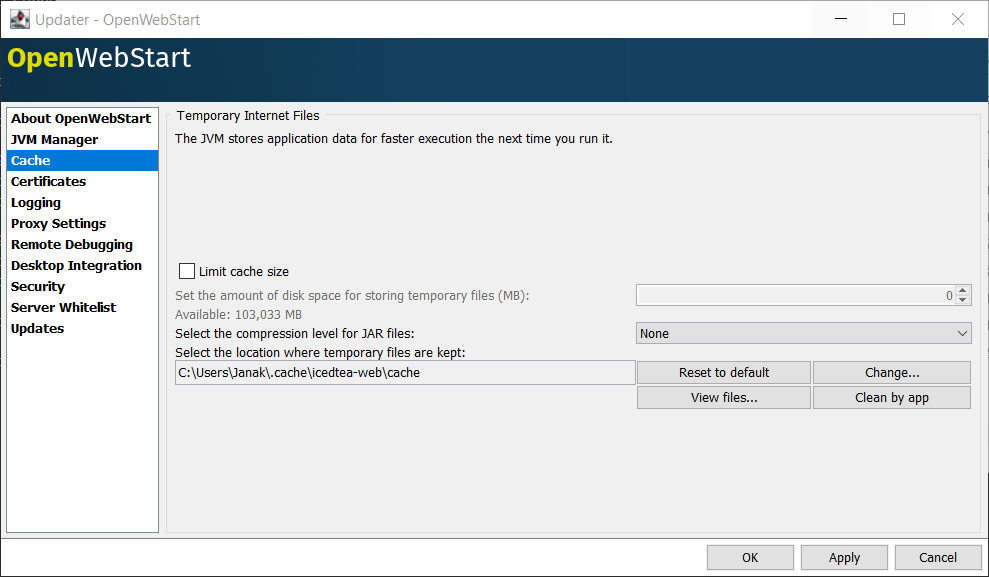
Figure 5. Configuring Enshroud Management
Application Management
An experimental feature has been provided to manage applications downloaded past OWS. This feature can be enabled by setting the following property in deployment.properties:
ows.experimental.applicationManager.agile=truthful 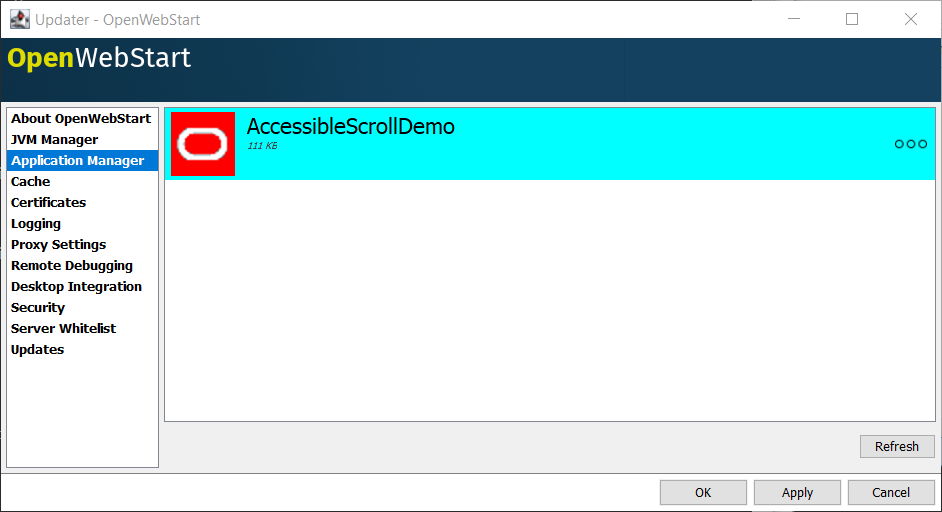
Effigy 6. Application Direction
The Application manager shows the listing of downloaded applications. It allows to:
-
beginning the application
-
create a shortcut
-
delete the application from cache
Proxy Settings
It is possible to configure proxy to be used by OWS when it downloads jnlp files and resource. OWS will utilize these settings to setup a proxy with the coffee.internet package. Equally a effect the proxy will besides be constructive for whatever connection the application is creating.
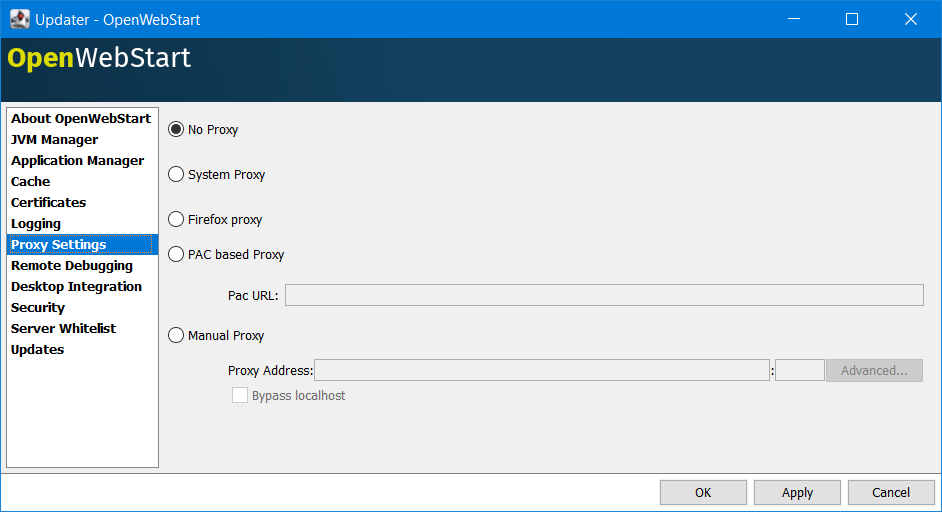
Figure 7. Proxy Settings
The System Proxy option is trying to imitate the behavior of your functioning system and the proxy settings which are defined there. E.g. for Windows the settings are read from the registry and and so converted into a java.net proxy. MacOS and Linux are working in a similar way.
- Annotation
-
It is not possible to delegate the responsibility directly to the Bone. Therefore the behavior of OWS may diverge from the behavior of your OS if System Proxy is selected. Ane known limitation is on Windows, where at that place is currently no back up for wildcards in the listing of excepted servers.
Security Settings
Security settings for OWS tin be configured in the Security panel:
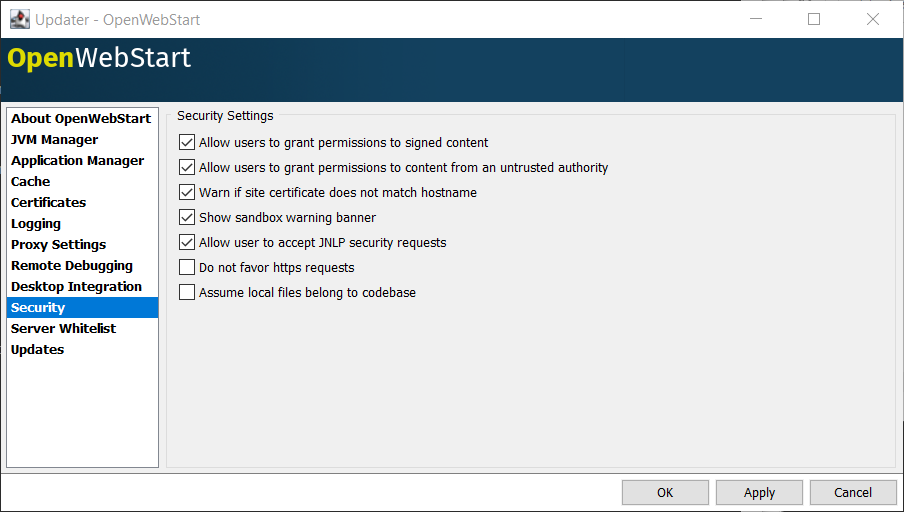
Figure eight. Security Settings
Suppressing security checks on manifest
If security related attributes (such every bit permissions etc) are missing in the manifest of a signed jar, OWS displays a Security dialog:
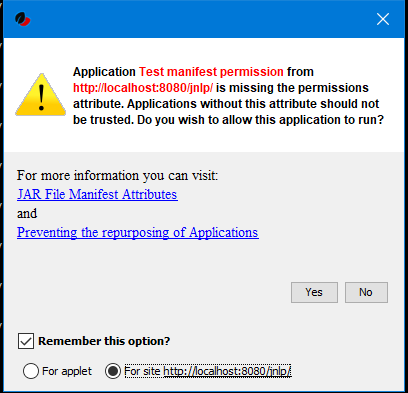
Figure 9. Secuirty Dialog
You tin choose to "Call back this option" for the site and Printing the Yes button. Your decision will be stored in the file <User_HOME>/.config/icedtea-spider web\.appletTrustSettings. Next time when yous start the jnlp you will not be shown the to a higher place dialog.
Alternatively, yous tin suppress the checking of selected or all manifest attributes past specifying the following property in your deployment.backdrop file:
deployment.manifest.attributes.bank check=NONE Default value of this belongings is ALL.
Other values for this holding are PERMISSIONS, CODEBASE, TRUSTED, ALAC, ENTRYPOINT. You tin can specify a comma separated list of the Manifest attributes to be checked past OWS. For case if you want all except the PERMISSIONS aspect to be checked by OWS ManifestChecker then you could specify:
deployment.manifest.attributes.check= CODEBASE, TRUSTED, ALAC, ENTRYPOINT Certificates
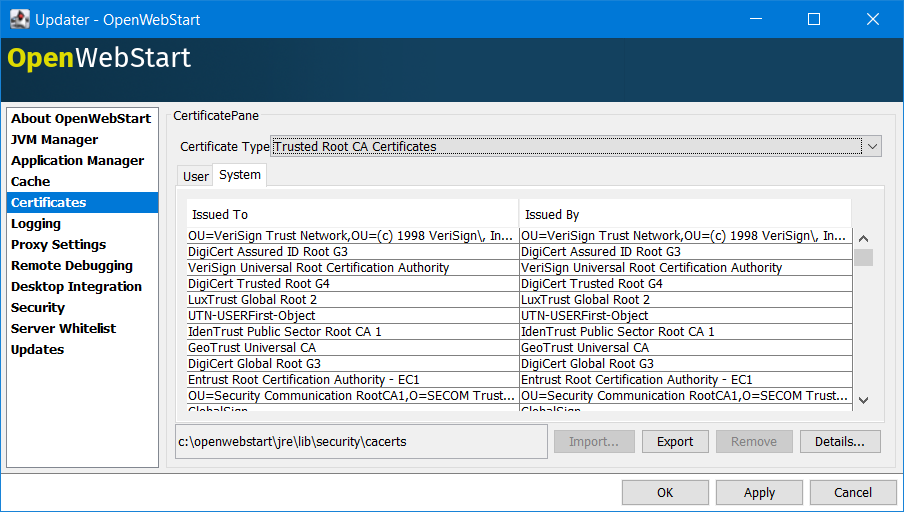
Figure 10. Managing Certificates
- TIP
-
The Organisation tab of the certificate view shows the certificates included in the embedded JRE. Since a JNLP application will non be launched in this JRE but in i which is managed by the JVM Manager, the certificates bachelor at runtime of the application may differ. The certificate view is as well accessible from the Java console. If launched from the Java console the certificate view volition show the certificates of the actually running JVM in the System tab. This can be used to check the certificates of the JVM which is executing the awarding.
If you want to import custom certificates you should do this in the User tab. This will ensure that the certificate is bachelor in any JVM which is launched by OWS.
OpenWebStart supports importing of PKCS12 certificates. Open the settings and go the tab Certificates then select the advisable user store and hitting "import…" Nigh probable you volition want to import a certificate to the Trusted Certificates or the Trusted Root CA Certificates.
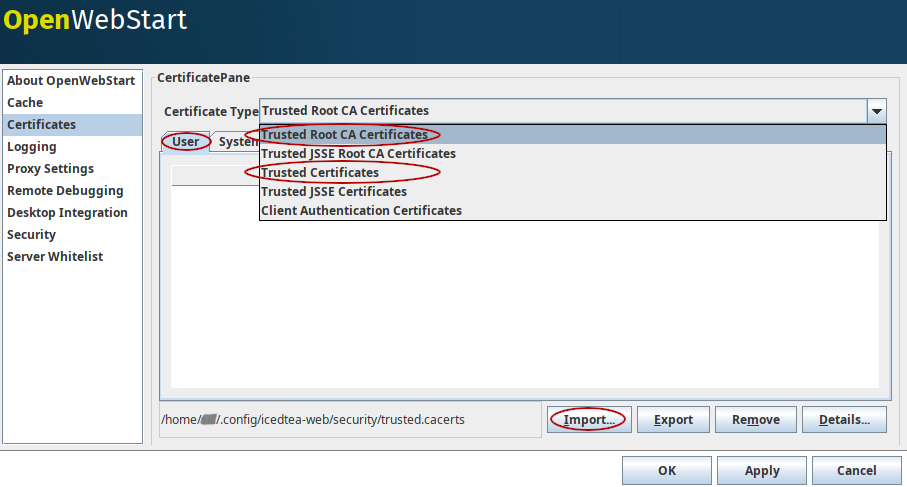
Figure 11. Import Document
Another possibility is to select the selection Always trust content from this publisher
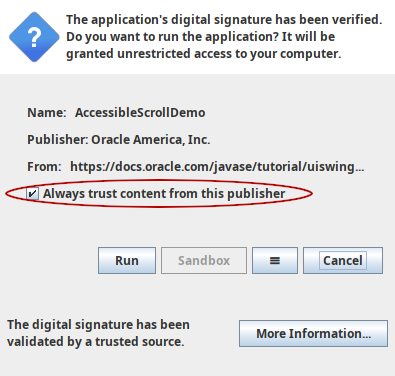
Figure 12. Always trust this publisher
- Annotation
-
OpenWebStart does not maintain a curated collection of certificates by itself. Rather it relies on the JVM which brings a default set of certificates. In this context it is helpful to distinguish between the bundled JVM, used to run OpenWebStart itself, and the custom-selected JVM used to launch the JNLP applications. While the bundled JVM cannot customized or replaced past an OpenWebStart user, the JVM used to run the JNLP application is determined by the definition in the JNLP file and by the configuration of the OpenWebStart JVM Manager. The certificates available during the execution of the JNLP application are those who come with the custom-selected JVM.
Logging
OpenWebStart provides access to log message data to monitor application execution and analyse erroneous beliefs past the Log Console GUI and log files. Both can exist enabled in the "Logging" console in OWS settings.
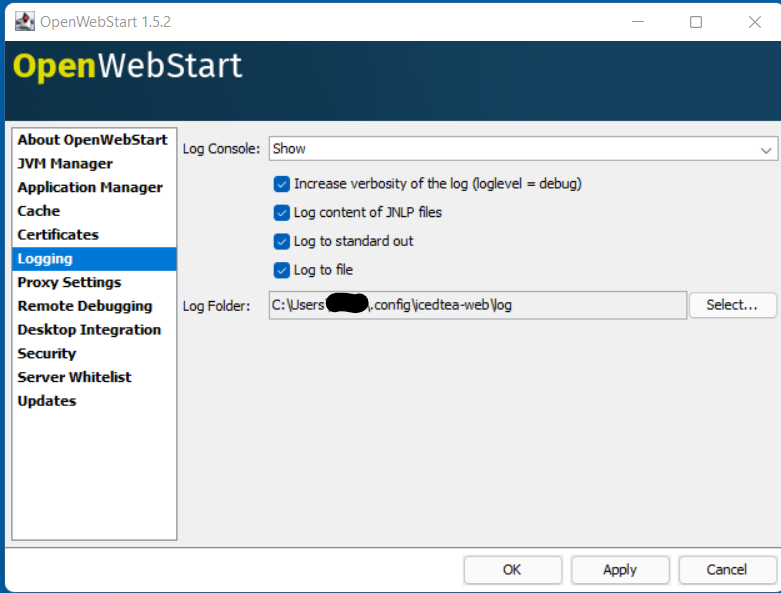
Effigy 13. Logging options in OWS Settings
Log Console
OpenWebStart provides the possibility to show a log panel window where all log letters of OpenWebStart itself and the launched JNLP awarding are displayed.
Various filter options can be selected to reduce the log output. To show the log console choose "Testify" in "Log Panel" selection.
Logging to Files
Logging to files tin be activated for file-based log analysis or to send the logs files to the OpenWebStart back up.
Y'all have to select "Activate debug logging", "Log to file", and specify the log folder where OpenWebStart should write the log files.
By default, this is <user_home>/.config/icedtea-web/log. Ensure that your folder has write access permissions when customizing this path.
When launching a JNLP application, OpenWebStart produces three log files for different stages. They all following the naming convention:
<timestamp>-ows-stage<phase number>.log The stage i file contains log events on the start-upwardly of OpenWebStart itself. It provides details on version and update status, embedded JVM version, JVM arguments, keystores loaded, validation and parsing results of the JNLP file, and details on the VM required by and used to finally launch the JNLP application. It ends with all the details about the control that OpenWebStart is nearly to execute to launch the JNLP awarding in stage ii.
Note: For MacOS there are really two log files for phase i. This is due to a technical limitation of the launcher OWS is using. The principal log file can easely exist determined by its size as it contains more log lines.
The stage ii file logs the events that happen when OpenWebStart launches the JNLP awarding. This is probably the near relevant log file for OpenWebStart users. It provides details on how the launch and execution of the JNLP application is going, such every bit the resources downloaded for the application. If your application cannot start properly, this log file is the best place to await for whatever error messages or stack traces.
Note that log files of the OpenWebStart Settings application also goes to this log directory. They are named
<timestamp>-ows-settings.log
You lot volition rarely demand those.
Remote Debugging
OWS allows remote debugging of the application started by OWS. You can configure the settings as follows:
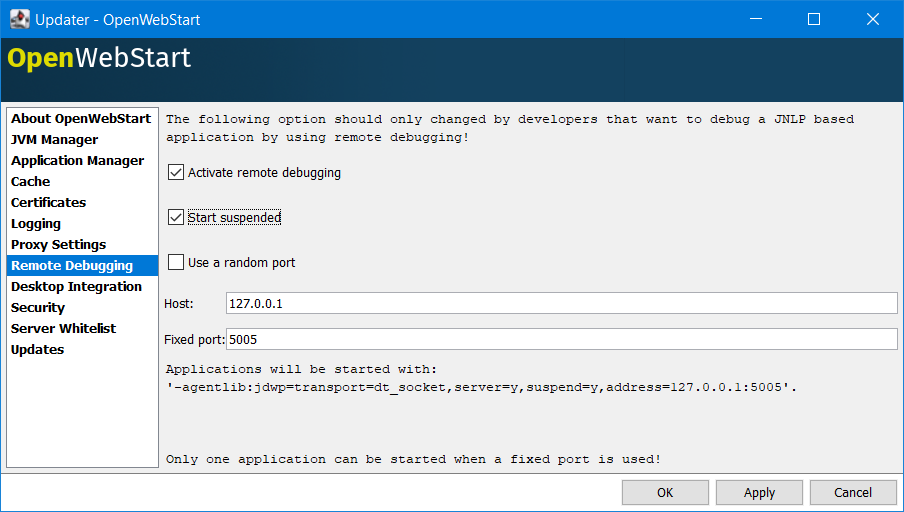
Figure 14. Remote Debugging
Desktop Integration
OWS allows to specify when and how desktop and showtime menu shortcuts are created.
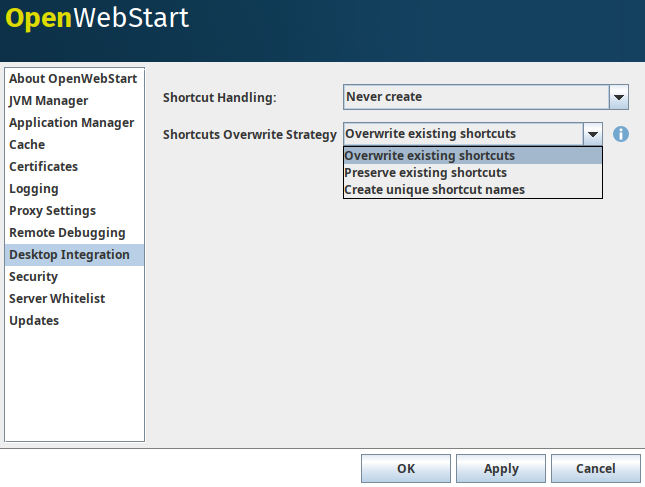
Figure fifteen. Desktop Integration
The options for when a shortcut is created are:
-
Never create: Never create a shortcut
-
E'er allow: E'er create a shortcut
-
Enquire user: Shows a dialog to ask user
-
Ask if hinted: Ask user if hinted in jnlp file
-
Always if hinted: Always create when hinted in jnlp file
The names of the shortcuts depend on the championship or the name of the jnlp file. This may lead to overwriting of the shortcut of 1 awarding by the shortcut of another application with the aforementioned title or jnlp file name. OWS provides the post-obit strategies for how shortcuts are created:
-
Overwrite: Ever overwrite existing shortcuts in instance of name clash
-
Preserve: Proceed the existing shortcuts in instance of proper name disharmonism
-
Unique Proper name: Create unique names for shortcuts by appending a hash suffix to prevent name clash.
You may also specify ows.shortcut.update.strategy property in the deployment.properties file with values OVERWRITE (default), PRESERVE or UNIQUE_NAME.
| Tip | On MacOS, application shortcuts are also added to the Launchpad when shortcut cosmos is turned on equally described above. If you lot desire to remove some or all of these shortcuts from the Launchpad, you take to delete the respective files in the <User Home>/Applications directory. |
OWS Command Line Arguments
OWS tin be started from command line as follows:
javaws <path or url of jnlp file> open -a "OpenWebStart javaws" <path or url of jnlp file> Some of the control line arguments are described beneath:
-Xoffline : Start a Jnlp application in Offline way
The Offline mode ways that OWS will not admission a server to fetch resource specified in the Jnlp file.
Y'all can commencement a previously cached Jnlp awarding in Offline manner using the post-obit command:
javaws -Xoffline myApp.jnlp open -a "OpenWebStart javaws" myApp.jnlp --args -Xoffline In the above instance myapp.jnlp is a previously downloaded and cached Jnlp file. OWS expects that the jars files for the app are available in the cache. For example:
<User Home>/.cache/icedtea-web/enshroud/0/0/myApp.jar Annotation that y'all will become java.cyberspace.ConnectException if you run javaws without the -Xoffline parameter when NOT continued to the server as OWS will try to fetch the resources from the server and fail.
-arg : Passing arguments to the application
javaws -arg arg1=value1 arg2=value2 -jnlp <path to jnlp file> - Mac
-
Since the JNLP file or URL comes at the terminate of that invocation on Mac this requires some statement wrangling. Y'all can passing arguments to the application using the post-obit trounce script:
#!/bin/bash # A wrapper for OpenWebStart that behaves like 'javaws' on MacOS. if [ "$#" -lt ane ]; then repeat "Must provide at to the lowest degree a JNLP file or URL" exit i fi # The JNLP file or URL which much be at the end of the statement listing. jnlp=${!#} # The balance of the arguments, if there are any. argarray=("${@:1:$#-ane}") open up -a "OpenWebStart javaws" "$jnlp" --args "${argarray[@]}" The specified arguments will be passed to the awarding'southward main method.
-allowredirect : Enable OWS to follow HTTP redirects.
javaws -allowredirect http://jogamp.org/deployment/archive/rc/v2.3.2/jogl-demos/Gears.jnlp Configuration Backdrop Overview
The following table provides an overview of the configuration properties of OpenWebStart.
| Note | The properties marked in the column LK are lockable. The properties marked in the cavalcade RV tin be specified in the response.varfile. Run into Configuration and Unattended Installation for further details. |
| Property | LK | RV | Clarification |
|---|---|---|---|
| ows.jvm.manager.cache.dir | X | Ten | Allows to specify the directory where the JVM cache is located. The follow example shows two examples for Windows: ows.jvm.manager.cache.dir=c:\\temp\\JVMCacheDir or ows.jvm.manager.cache.dir=c\:/temp/JVMCacheDir |
| ows.jvm.manager.cache.cleanup | Ten | X | Allows to disable the cleanup of the local JVMs. Default is true. The benefit of disabling this is to avoid race conditions if 2 instances of OWS are launched at exactly the same time. |
| ows.jvm.manager.server.default | X | X | This property must contain a valid URL that defines the server that is used to download new JVMs. |
| ows.jvm.manager.server.allowFromJnlp | 10 | 10 | Defines if a custom URL can be used to download a JVM. Such URL tin can be part of a JNLP file. |
| ows.jvm.manager.server.allowFromJnlp.whitelist | X | X | A comma separated list of urls that are divers equally whitelist. The whitelist is checked whenever OpenWebStart volition download a JVM from an URL out of a JNLP file. |
| ows.jvm.manager.vendor | X | X | Defines a specifc JVM vendor. By doing so, only JVMs from that vendor volition be downloaded. You lot can use '*' to allow any vendor. |
| ows.jvm.manager.vendor.allowFromJnlp | X | X | Defines if a vendor aspect in a java/j2se tag of the JNLP file should be respected. If a specific JVM vendor is divers, this is false i.eastward. the vendor from the settings has precedence by default. If "Whatsoever Vendor" is selected in OWS Settings, this property is true to take the vendor hint of the JNLP file into consideration. |
| ows.jvm.director.updateStrategy | X | X | When starting a JNLP application, OpenWebStart tin can check if an updated JVM is available to run the application. This belongings defines how OpenWebstart behaves in the JVM check. Possible values are NO_REMOTE (never check the update server), DO_NOTHING_ON_LOCAL_MATCH (practice not check for updates on local match but exercise download if no local lucifer establish), ASK_FOR_UPDATE_ON_LOCAL_MATCH (cheque for update on local match but ask earlier installing new JVM) and AUTOMATICALLY_DOWNLOAD (check and install for newest JVM) |
| ows.jvm.managing director.versionRange | X | X | Allows to limit the possible JVM versions. Must be valid version-string according to JSR-56 Appendix A. |
| ows.jvm.manager.searchLocalAtStartup | X | X | If set to truthful OpenWebStart will search for new local JVMs at every start. Default is false. |
| ows.jvm.manager.excludeDefaultSearchLocation | X | X | If set to truthful OpenWebStart will exclude the default locations when searching for JVMs. Default is false. |
| ows.jvm.manager.customSearchLocation | Ten | X | Comma separated list of custom locations to search for JVMs. Default is empty. |
| deployment.proxy.http.host | X | X | The HTTP proxy hostname. |
| deployment.proxy.https.host | 10 | X | The HTTPS proxy hostname. |
| deployment.proxy.http.port | X | Ten | The HTTP proxy port. |
| deployment.proxy.https.port | Ten | X | The HTTPS proxy port. |
| deployment.proxy.featherbed.local | X | Ten | All local hosts should be bypassed. Default is faux. |
| deployment.proxy.bypass.listing | 10 | Ten | A comma separated list of host names that should bypass the proxy. |
| deployment.proxy.type | Ten | X | The proxy type that should be used. Possible values are 0 (no proxy), 1 (manual proxy), 2 (PAC based proxy), iii (Firefox), four (system proxy). Default is 4-Arrangement |
| deployment.proxy.motorcar.config.url | X | Ten | The URL for the proxy auto-config (PAC) file that will be used. |
| deployment.proxy.aforementioned | X | 10 | If true use the same web server and port for https and ftp equally is configured for http. (This is only valid if deployment.proxy.type = i (manual proxy). Default is false. |
| deployment.cache.max.size | X | Ten | The cache maximum size. Default is -1 |
| deployment.https.noenforce | X | X | If set to truthful http urls are not converted to https. Default is imitation. |
| deployment.assumeFileSystemInCodebase | X | X | Defines if files from the local filesystem are always handled as if they would be part of the codebase. |
| deployment.manifest.attributes.check | X | 10 | Defines which checks should exist performed for all jars. See Suppressing security checks on manifest for details |
| deployment.security.whitelist | - | X | A comma separated list of urls that are defined as whitelist. The whitelist is checked whenever OpenWebStart will download a resource (like a JAR file). |
| ows.jvm.manager.maxDaysUnusedInJvmCache | X | X | Max number of days an unused JVM stays in the JVM cache. The default is 30. |
| deployment.log | - | X | If set to true debug logging is enabled. Default is false |
| deployment.log.file | - | Ten | If set to truthful log is outputted to file. Default is false |
| ows.update.activated | X | X | Defines if OpenWebStart should automatically search for updates. |
| ows.checkUpdate | X | X | This property has no result and is but used to lock functionality in the user interface. If this property is locked, a user cannot manually search for OpenWebStart updates. |
| ows.update.strategy.settings | X | X | Defines how ofttimes OpenWebStart should search for updates when opening the settings windows. Allowed values are ON_EVERY_START, DAILY, WEEKLY, MONTHLY, and NEVER. |
| ows.update.strategy.launch | 10 | X | Defines how ofttimes OpenWebStart should search for updates when starting an application. Allowed values are ON_EVERY_START, DAILY, WEEKLY, MONTHLY, and NEVER. |
| deployment.connection.connectTimeout | X | HTTP request connect timeout in milliseconds. Default is 10000 ms i.e. 10 southward. 0 means infinite look. | |
| deployment.connection.readTimeout | X | HTTP asking read timeout in milliseconds. Default is 10000 ms i.e. 10 south. 0 means infinite wait. |
Source: https://openwebstart.com/docs/OWSGuide.html
0 Response to "Could Not Read or Parse the Jnlp File Ice Tea"
Post a Comment